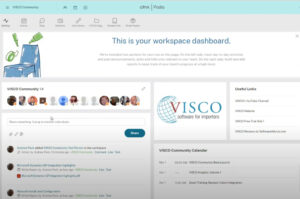How a specialized logistics and distribution ERP integrates with existing Accounting software…successfully
As co-founder and head of VISCO Operations, I’m often asked to justify a decision we made 19 years ago when we developed our highly focused logistics and distribution ERP without including basic accounting functions that we ourselves had written from scratch. I have many explanations at the ready, but I am most frequently reiterating a singular point that holds true today more than it did even back then when we sat around the conference room table and decided on our application architecture.
Accounting systems (ostensibly A/P, A/R, and GL) have already been made and made well since the 1980s. I can recount any number of perfectly viable options for collecting invoices from vendors and sending invoices to customers and for managing a general journal. Quality products exist already at every business level, from classics like Open Systems, Great Plains or QuickBooks Desktop to cloud based contemporaries like XERO, Business Central or QuickBooks Online. Could we match or do better than the elegant simplicity of accounting functions in QuickBooks Desktop back in 2001 with our small (but eager!) highly specialized Dev team? We predicted it was unlikely and, well, we were right.
While QuickBooks Desktop went on to become the most successful small business accounting system in the world, we’ve grown consistently through dedication and focus on our specific niche; To deliver customizable tools and features for importers and exporters to conduct global trade effectively.
Back in 2001, the design and development team at VISCO already had over 75 years combined experience in tracking inventory during the various stages of import/export distribution for small to medium sized businesses. In other words, we knew early on where “our bread would be buttered.” The challenge then became: How can we deliver a full solution to potential customers when our software alone offered maybe 70-80% of the total functionality needed? In comes Accounting Integration.
Integration is a term throw out pretty easily these days. In the last decade, Application Programming Interfaces (APIs) have revolutionized how easy it has become to transfer data between software applications. When we started though, integration was a bad word, and the thought of connecting our application with another meant we were already a step behind competition before we even walked in the door with prospects. Thankfully, that has changed in a major way in the last ten years.
We had decided we would need to become experts in integration almost 20 years ago because we knew there were others out in the world “doing accounting” better than we were. There were also others doing a better job with Computer Aided Design (CAD), State Tax Reporting, or Rail Location services than we were too and the key was to find easy and reliable ways to merge their systems with ours rather than try to duplicate what had already been done.
Well, if I may be so bold as to say it, technology has caught up with our approach thankfully and we are now proud to call ourselves Logistics and Software Integration Specialists. Since integration is as much in our DNA as landed cost is now, we can focus on delivering a fully formed ERP, comprised of many parts, a key part of which we developed ourselves, namely VISCO software. We go into every new relationship with full transparency stating what we know to be the case:
- We are experts in Logistics Management: From chemicals to plastics, seafood to wine…we know a lot about moving products from one place to another and the cost and documentation involved in those movements.
- We are experts in Software Integration: We have decades of experience working with SDKs and their newer, friendlier API counterparts. We have imported and exported data in XLS(X), CSV and TXT over FTP or HTTPS too many times to count. We have developed our own API in recent years as well, so integrations in either direction are more reliable and consistent than ever, especially with our cloud based partners.
- We have a support team capable of offering high level support to not only our system, but to many of our integration partners. The flexibility of our system requires a certain approach to support which gives us a very strong foundation on how to quickly pick up the “language” and “behavior” in any number of software applications our customers are using.
- Our approach to support with our customers is all encompassing. We charge a blanket price for support and maintenance and understand that a fully formed ERP package requires support of many systems that will tie into VISCO as well.
In other words, we understand that our “bread is (truly) buttered” by the success and happiness of our customers, and the best way to ensure that is to offer a single point of contact for our customers in regards to software. Concerns about managing two systems quickly fade with our customers when a reliable, well supported, ERP package is delivered and maintained by our team.
So when prospects ask me to justify our decision now, I can tell them any number of things and usually do (I can be a bit wordy when given the audience!). But if asked to summarize quickly, I simply say…
“Our specialty is in logistics and distribution. We have a strong knowledge of integrations with and functionality of well-designed accounting packages as well. We are happy to “plug-in” with the parts of accounting you are already happy with, or offer a cost effective and complete ERP solution with a single point of contact for all your support questions.”
..And usually, that does that trick! 🙂





